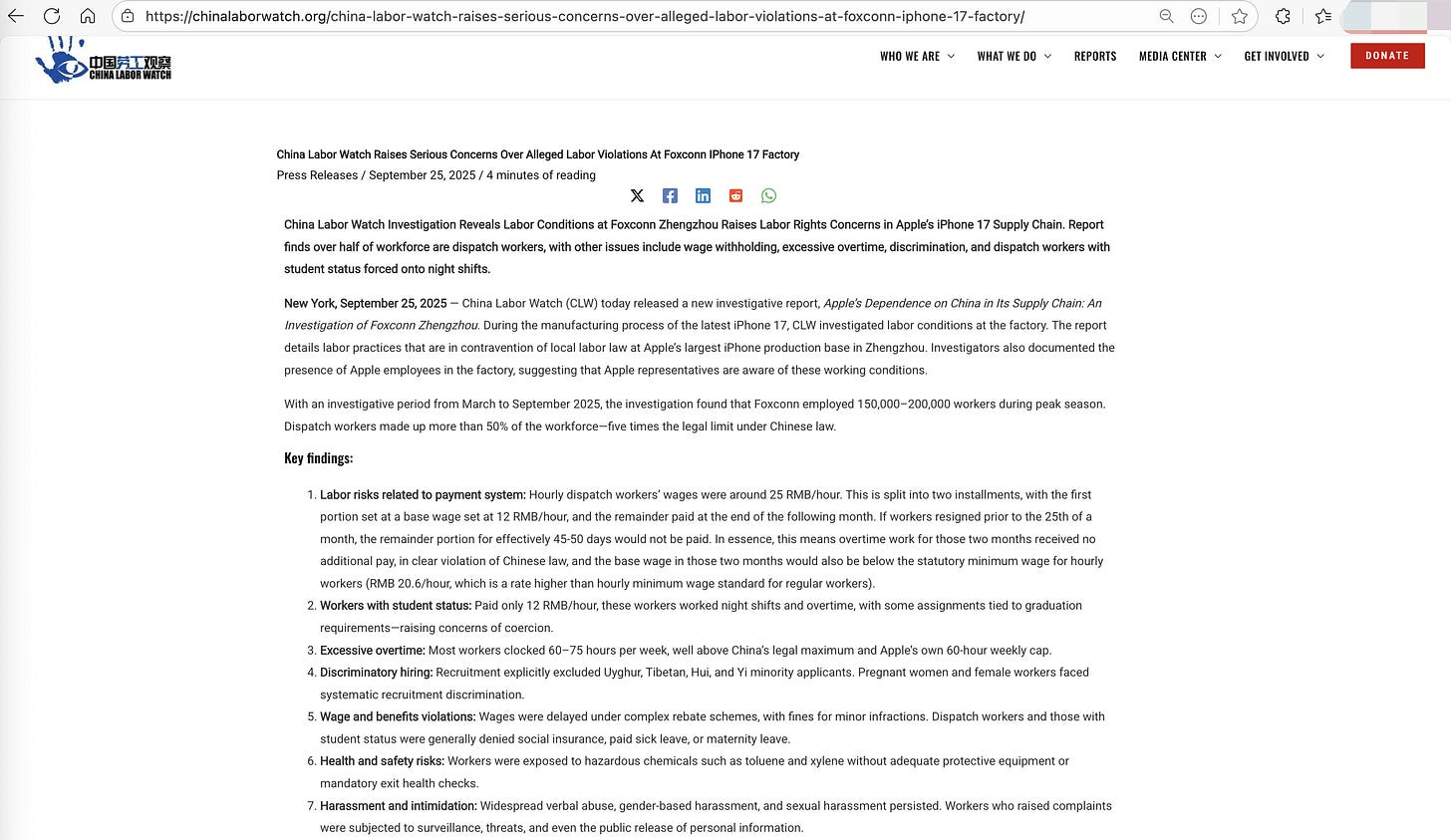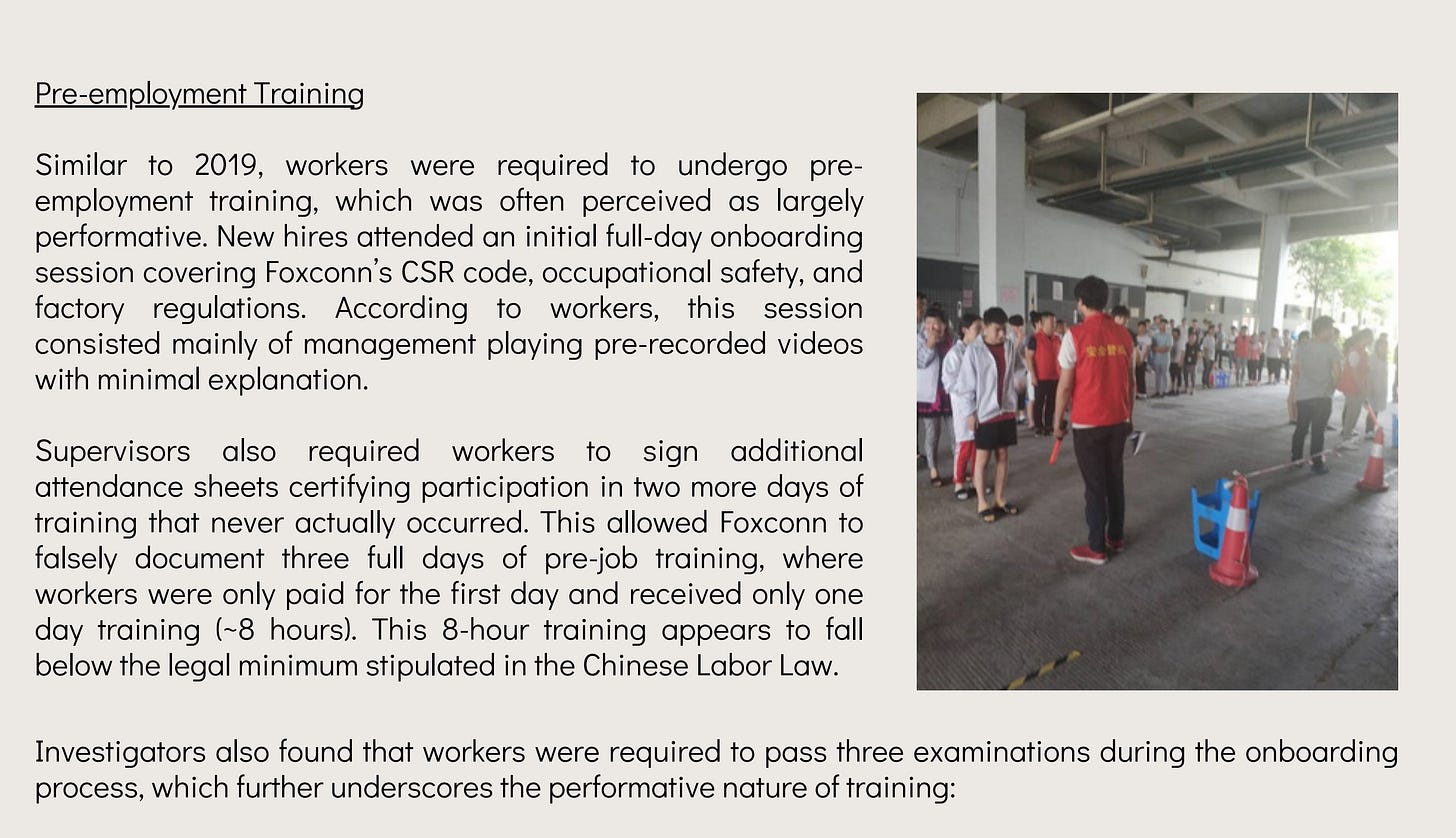From “Clues” to “Reverse Identification”
Reading Apple’s Dependence on China in Its Supply Chain An Investigative Report on Foxconn Zhengzhou —An Open Letter to Supporters and Peers
作者 | Author:ESG合作促进中心(ESG Cooperation Hub, Hong Kong)
联系 | Contact:fermi.wang@esghub.hk
From “Clues” to “Reverse Identification” / 从“线索”到“反向锁定”
Reading Apple’s Dependence on China in Its Supply Chain An Investigative Report on Foxconn Zhengzhou / 读《Apple’s Dependence on China in Its Supply Chain An Investigative Report on Foxconn Zhengzhou 》有感
—An Open Letter to Supporters and Peers / 也是一封给支持者与同行的公开信
Finishing Apple’s Dependence on China in Its Supply Chain An Investigative Report on Foxconn Zhengzhou( Hereinafter referred to as “Foxconn Zhengzhou (September 2025)”), my first concern was not to debate wages, hours, or temp labor per se, but something more urgent: does the report itself contain enough narrative and material “breadcrumbs” for an adversary to reverse‑identify those who spoke up? In China’s hyper‑digitized mega‑factories, information is never isolated. Badge logs, HR data, CCTV, workflow trails, and device forensics stitch fragments together. This report, unfortunately, leaves more than a few such stitches.
当我读完《Apple’s Dependence on China in Its Supply Chain An Investigative Report on Foxconn Zhengzhou 》(后文简称《Foxconn Zhengzhou(2025年9月)》)时,第一反应并不是争论报告里关于工资、工时或派遣用工的事实,而是一个更紧迫的问题:报告本身遗留的叙事与素材,是否足以让对手“顺藤摸瓜”,反向锁定那些向外界说真话的人?在中国这样高度数字化管控的超大型工厂里,信息不是零散的,它们会被门禁、人事、摄像、流程日志和设备取证“拼起来”。而这份报告,恰恰留下了不少可以被拼接的“线索”。
Let’s be clear: no one should pay a personal price for telling the truth. Yet the reality is that Foxconn‑scale firms maintain end‑to‑end security stacks: structured HR/dorm data, minute‑level access and CCTV replay, internal app logs, compelled device forensics, and continuous monitoring of public social channels and recruiter groups. All road‑legal, all optimized for one outcome—find “who leaked” as fast as possible. Against this capability, the report’s “ordinary details” become searchable keys and coordinates.
先说清楚:没有任何人该为说真话而付出人身代价。但现实是,富士康这样的巨型组织早已具备完整的安保与信息控制链条:结构化的人事与宿舍数据、分秒计的门禁与摄像回放、内部应用的操作日志、对手机与电脑的强制取证,以及对公开社媒与招聘群的持续监测。一切都合法合规地指向一个目标——在尽可能短的时间里找出“谁泄露了信息”。在这样的对手能力面前,报告里的“看似普通的细节”,就会变成可被批量搜索、交叉验证的关键字与坐标。
What are these “details”? Not names or IDs, but combinations that become unique: month‑specific field windows and mentions of entering shopfloors or medical checkpoints; worker vignettes that co‑list age, onboarding month, shift from agency to regular, line size, dorm residence, commute duration/mode, and process hints (e.g., proximity to a robotic arm or molding); internal jargon, unit names, and workflow app labels; and incident anchors like “reprimanded for photographing at medical check” that are trivially queryable in CCTV and duty logs. Each item is harmless alone. In a system with Access+HR+CCTV+Logs, the combination narrows from tens of thousands to dozens, to one.
这些“细节”是什么?不是姓名与工号那样直截了当,而是组合起来会唯一化的叙事元素:明确到月份的调查窗口、进入车间或体检点的行动轨迹;“工人故事”里并列出现的年龄、入职月份、是否从派遣转正、所在产线规模、是否住宿舍、通勤时间与方式、身边的工艺线索(例如邻近机械臂或注塑位);报告中出现的内部术语、业务单元与流程应用名称;以及“体检拍照被当场训诫”之类可以直接在摄像和当班记录里检索到的事件锚点。单看每一条都并不起眼,但把它们放进一个拥有门禁库+人事库+CCTV+流程日志的系统里,样本会从数万迅速收敛到几十、个位数,甚至唯一。
Picture the adversary’s workflow. Step 1, structured filtering—use the report’s window to pull current/new entrants, then layer fields like “female/23/onboarded in late‑2024/agency→regular/hundred‑person line/dorm resident/30–40 min walk/near robotic arm” to slash the candidate set. Step 2, workflow cross‑checks—flag unusual exit/transfer approvals; corroborate anomalies in medical/training ledgers. Step 3, CCTV replay—face+badge+time across shop entrances, corridors, and the medical site to stitch the dorm‑to‑gate‑to‑shop path. Step 4, device forensics—seize and image “high‑suspect” devices, index chats/docs/image hashes/metadata, then template‑match against layout fingerprints glimpsed in the public report. Step 5, online tracing—track similar texts and timestamps across public posts and recruiter groups; when needed, apply doxx‑and‑pressure to force deletions and confirm identities. Step 6, evidence fusion—once two or more chains (access/CCTV/logs/forensics/online) corroborate, the organization can push one individual into the spotlight.
想象一下对手的工作台:第一步,结构化初筛——按报告写明的时间窗口,拉取在岗与新入人员,再叠加“女性/23岁/2024年下半年入职/先派遣后转正/百人级产线/住宿舍/通勤30—40分钟/邻近机械臂”这样的字段组合,候选名单立刻锐减。第二步,流程交叉——在内部应用日志里查是否有离岗、跨区、异常审批;在体检与培训台账里核对异常行为记录。第三步,CCTV回放——对车间入口、走廊、体检点做人脸+工牌+时段的三维回溯,拼出“宿舍—厂门—车间”的完整行走链。第四步,设备取证——对“高可疑”人群启动扣机与镜像,检索聊天记录、文档片段、图片哈希与元数据,再拿报告里出现过的文件版式做模板匹配。第五步,线上溯源——追踪公开平台与招工群的相似文本与时间序列,必要时以“人肉+施压”迫使删帖,从而完成反向确认。第六步,证据合并——当门禁、视频、流程、取证、线上出现两条以上相互印证的链路,组织就能把某个个体推到台前。
The issue, then, isn’t whether names were redacted; it’s whether de‑identification matches the adversary’s capacity. Where a system can query access, CCTV, and workflow in hours, any co‑listed high‑granularity fields become a unique tuple. Add compelled device unlocks and “river‑patrol” searches across public web posts, and pulling one person from a crowd is no longer hard. Hence, cadence is protection: a cooling‑off period lets staffing rotations and dorm reshuffles blur trails; narrative minimization turns months into quarters and incident anchors into aggregated language; “worker stories” become ranges and group descriptors rather than combinable specifics.
问题因此不是“有没有把姓名打码”,而是去特征化是否与对手能力匹配。当一个系统能够在几小时内调用门禁、摄像与流程日志,任何同时出现的高粒度字段都会变成“唯一化组合”。再叠加强制设备解锁、对外网发声的“巡河式”搜索,把人从人群里捞出来,其难度已不是想象中的那样高。这也是为什么,在高风险语境下,发布节奏本身就是保护:给一段时间“冷却”,让人事变动、排班切换、宿舍调配冲淡线索;给叙事做降敏,把月份变成季度,把“某日下午在体检点拍照被制止”改为“有个别员工在入职流程中遭遇不合理限制”;把“工人故事”的画像拆散成区间、范围与群体化表达,尽量避免“能被拼起来”的并列。
This is not nitpicking prose; it’s do‑no‑harm as a craft in hostile settings. People often argue “less detail means less credibility.” In practice, credibility and traceability share the same raw material—the more vividly a scene is painted for readers, the easier it is for adversaries to locate the scene in their systems; the more “real” a person appears on the page, the faster that person can be pulled from a database. The line between “verifiable” and “traceable” must be clear and conservative, drawn by a Source Protection Officer—not the program lead—and backed by veto power.
我必须强调,这不是挑剔文字技巧,而是不伤害原则(do‑no‑harm)在极端环境下的基本功。很多人会说,“不写细就没有说服力”。可在现实里,“说服力”往往和“可追溯性”同源——越能让读者看到场景,越能让对手在系统里定位场景;越能让读者认识一个“真实的人”,越能让对手把这个“人”从数据库里捞出来。因此,“可验证”与“可追溯”之间需要一条清晰、保守的边界,这条边界应该由源保护官而不是项目负责人来划定,并且拥有否决权。
I write this publicly because the pattern is not isolated. Across projects, partners, and topics, the same de‑anonymization risks recur: timestamps too precise, locations too tight, profiles over‑specified, screenshots leaking layout fingerprints, acknowledgments and appendices leaving tell‑tale crumbs. We need facts, yes—but not facts bought with the safety of truth‑tellers. In a text like Foxconn Zhengzhou, we can preserve evidentiary force through aggregation, de‑identification, and time‑shifted releases—evidence that persuades without offering machine‑readable coordinates.
我之所以把这段话公开写出来,是因为这类问题并非孤例。不同项目、不同合作方、不同议题中,同一种去匿名化风险反复出现:把时间写得太实、把地点写得太细、把画像拼得太满、让截图露出“版式指纹”、在鸣谢或附录里留下注脚般的破绽。我们当然需要事实,但不是用说真话的人去“换取事实”。在《Foxconn Zhengzhou》这样的文本中,我们完全可以通过聚合数据、去标识化叙述、时移发布来保留证据的说服力,同时不给对手提供“机器可读”的坐标。
No, these adjustments won’t erase all risk. Adversary systems will keep improving; new cross‑joins will appear. But we can do at least two things: (1) keep public detail strictly below the uniqueness threshold; (2) treat publication as a process, not a moment—red‑team drills, cooling‑off windows, dual‑sign reviews. For funders and international peers, it’s time to turn source protection from “principles and pledges” into grant clauses and audits: minimum baselines, remediation timelines, external reviews, and remedy channels for those already harmed.
我知道,这样的调整并不能消除一切风险。对手的系统会继续变强,新的交叉方式会不断出现。但我们至少要做两件事:其一,把可公开的细节严格限定在“无法被唯一化”之内;其二,把发布当作流程而非瞬间——设红队演练、设冷却期、设双签审查。而对资助方与国际同行来说,是时候把源保护从“倡议与口号”变成合同条款与审计项:设最低标准、设整改时限、设外部复核;为已经受伤的人建立救济通道。
If you’ve read this far, pass it to anyone still gathering evidence, drafting reports, or making release calls: “Protection before storytelling; safety before publication.” The goal is not to be vague; it’s to be safe for people and faithful to evidence. In the end, what moves a system forward is not only the courage to expose, but the competence to ensure exposers don’t get hurt. Foxconn Zhengzhou (Sept 2025) is a timely reminder of both the urgency and the necessity of that competence.
如果你读到这里,请把这段话转给任何还在一线收集证据、还在写报告、还在做发布决定的人:“先保护,再叙事;先安全,再发布。”我们不是要写得空泛,而是要写得对人安全、对证据负责。说到底,真正让一个体系进步的,不只是披露的勇气,还有不让披露者受伤的能力。《Foxconn Zhengzhou(2025年9月)》提醒我们的,正是这件事情的紧迫与必要。
联络 / Contact
ESG合作促进中心(ESG Cooperation Hub, Hong Kong)
fermi.wang@esghub.hk



